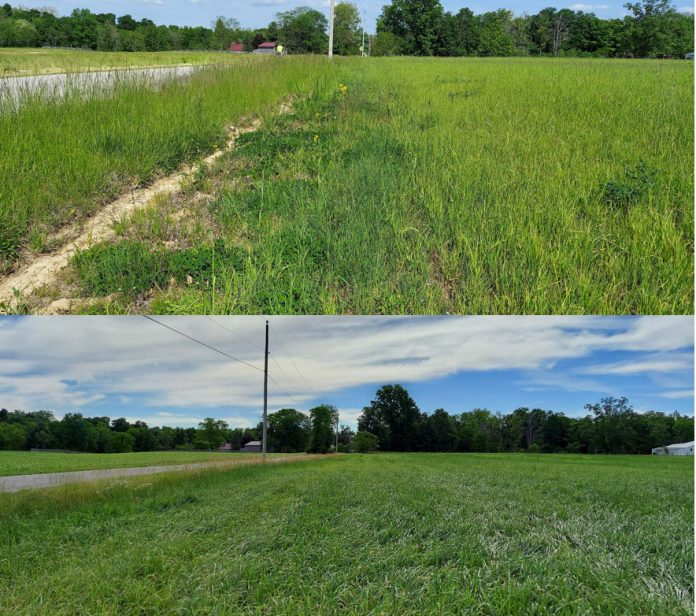
By James Morris and Greg LaBarge | Ohio State University Extension
As the calendar flips over to August and temperatures continue to rise, our cool-season forages are in the heart of what we call the “summer slump” and vegetative growth begins to decline. Numerous resources are available that provide excellent strategies for reducing the negative effects of this slump. Forage growers can utilize summer annuals to boost yields during this time of the year, but it’s also important to ensure our forage stands are healthy prior to being exposed to heat and other environmental stressors.
So, while “summer slump” seems to get all of the attention right now, what if our forages had “spring fever”? We normally consider springtime to be the period of rapid and lush growth for our cool-season forages, but what if our stands look like that in the top part of the photo? The top image was taken this spring in a stand of a cool-season hay mix. Of course, this problem will impact tonnage, but a weak stand will also allow more opportunities for weed emergence, reduce winter survival, and as mentioned above, reduce their ability to tolerate stressful summer conditions. While it may be too late to beat the heat, action can still be taken to prepare forages for winter and set ourselves up for a better spring.
What’s the issue with this stand and the several others I visited this spring? Let’s put ourselves into the situation as if it was our own field. Where do we begin? Well, stunting and yellowing can be descriptions of numerous issues related to plants. As we further survey the field, a defined difference between plant health is visible between the edges and center of the field. What was done differently along the edges? Less compaction from equipment, no herbicide application, and no harvest. We ruled out herbicide injury and didn’t notice any extreme compaction. So, we took soil samples and found the culprit. Extension educators sometimes sound like broken records as we always advise, “don’t guess, soil test.” This is a prime example of how soil results can easily take the guesswork out of problem-solving.
Nutrient removal
Using the recommended critical levels from the Tri-State Fertilizer Recommendations (go.osu.edu/tri-statefert), the results showed us that the soil phosphorus (P2O5) was only 8 ppm below the critical level, but soil potassium (K2O) was 76 ppm below the critical levels.
Why is there such a big difference in soil levels? Let’s think about what type of fertilizer was being used. Most fields I see in this condition have had repeated applications of a balanced fertilizer such as 19 (N)-19 (P)-19 (K). What’s the issue with a balanced fertilizer? Well, according to our newest Nutrient Removal for Field Crops fact sheet (ohioline.osu.edu/factsheet/anr-96), a cool-season grass hay mix can remove 12 pounds of P2O5 and 48 pounds of K20 per ton of forage production. Again, let’s put ourselves in this situation. If our hay averages 3 tons/acre yield at harvest, our crop potentially removed 36 pounds of P2O5 and 144 pounds of K2O. Hopefully, this helps explain why we saw such a large difference in the soil nutrient levels.
Now, we apply 200 pounds/acre of 19-19-19 fertilizer. That equals 38 pounds of P205 and K20 applied. As you can see in Table 1, this meets our replacement needs for P205 but only replaces about 26% of the K20 that was used. If our soil levels were already deficient as shown in our example, much larger rates will be needed to begin our “build-up” process. As you can imagine building soil levels back up within our critical ranges can become expensive.
Since a balanced fertilizer doesn’t match our unbalanced nutrient removals, we can consider using a fertilizer such as 9-23-30. An application of 200lbs/acre of this fertilizer would return 46 pounds /acre of P205 and 60 pounds /acre of K2O. This allows us to begin building up our P205 levels and replace about 41% of our K2O. We can apply additional K2O with the use of 0-0-60 (potash) fertilizer.
Of course, fertilizer costs and our return on investment is also a factor in this decision-making process. Will we get enough yield boost to pay for the fertilizer? I am working with a producer in Brown County to conduct on-farm research that may help answer that question. We made a base application of 9-23-30 and will follow up with three replications of an additional application of potash versus no additional application. Yield and return on investment results will be available in our 2021 OSU eFields publication.
Developing fertilizer recommendations
Now that we understand the nutrient removals rates and the approaches that can be used to maintain and build adequate fertility, how do we calculate the fertilizer needs? If you despise math, don’t quit reading just yet. Our team at OSU Extension has developed an easy way to calculate nutrient needs based on soil test results and it doesn’t require lengthy calculations. This spreadsheet utilizes information from the resources provided in this article to compute nutrient needs. Users simply input their soil test results, crop information, and yield expectations.
The spreadsheet will automatically calculate the needs and costs per acre of P2O5, K2O, and lime applications. This spreadsheet, along with a user guide and more background information can be found at go.osu.edu/FertilityCalculator. Applying this information to create an accurate fertilizer plan for your forages can significantly increase production in deficient soils.
(James Morris is an OSU extension educator in Brown County. He can be reached at morris.1677@osu.edu. Greg LaBarge is an OSU extension field specialist in agronomic systems. He can be reached at labarge.1@osu.edu.)












